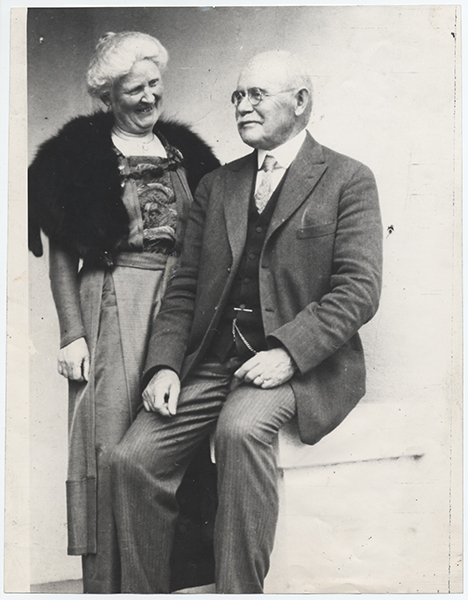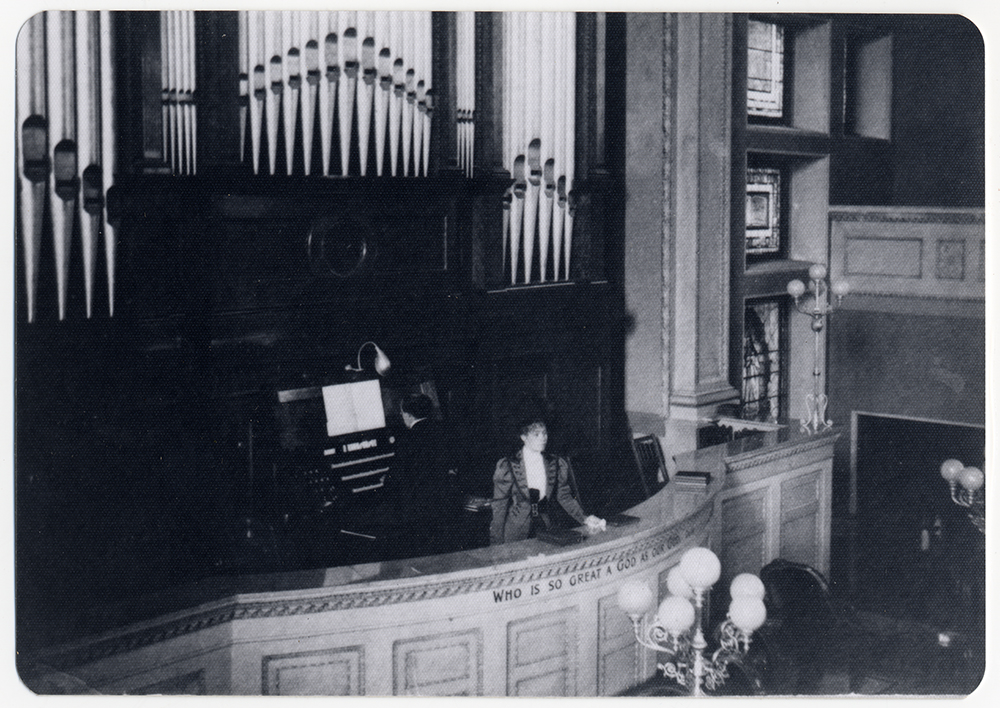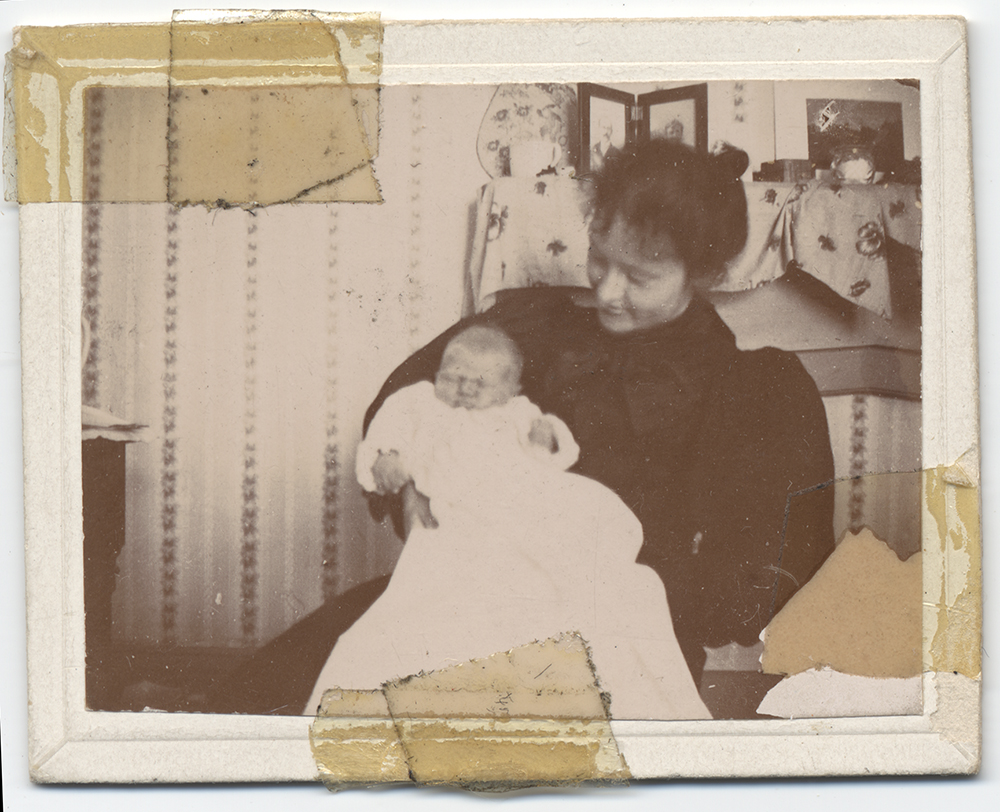
THE DEDICATION of The Mother Church Extension on June 10, 1906 was an inspiring occasion for the thousands of enthusiastic Christian. Scientists who had come to Boston from all over the world for this day of progress and fruition. Six services were held on that day with more than 30,000 in attendance.
It must have been a rewarding experience for Mrs. Laura C. Conant, the Second Reader, and her husband, Albert F. Conant, who played the magnificent new organ for all services.
In her memoirs, Mrs. Conant described that eventful day and how it felt to stand on the Readers’ platform under the vast arching dome and look out over a sea of eager faces. Not a seat was vacant and there were thousands on the street waiting to attend the next of the day’s services.
“The morning of the Dedication” she wrote, “found us on the platform at 7:30 o’clock facing a congregation of 5,000 people. And when that vast congregation, led by the powerful organ, sang our Leader’s Hymn that begins ‘Shepherd, Show Me How To Go,’ it was one of the most thrilling experiences of my life.”
Mrs. Conant was well prepared to share the reading of the first service in this grand new edifice. She had had the privilege of class instruction under Joseph Armstrong, C.S.D., had in recent months entered the public practice of Christian Science, was a graduate of Emerson College of Oratory in Boston, a well-known school of speech and expression, and had made many public appearances.
Mr. Conant, also taught by Joseph Armstrong, was a listed practitioner in The Christian Science Journal for several years, and was the last of the regular organists in the original edifice of The Mother Church. He had acquired a reputation in the Boston area as an excellent musician, especially in church and concert organ work.
In 1905 new Readers were again chosen for the Original Edifice — they would be the first to read in the new Extension and would naturally participate in its dedication. The Directors had given Mary Baker Eddy, the Discoverer and Founder of Christian Science, the names of members they thought suitable for First and Second Readers. Mrs. Eddy approved William McCrackan of New York City for First Reader, but Mrs. Conant was recommended for Second Reader. Mrs. Conant wrote, “I would have taken the position with considerable trepidation had it not been that my education at Emerson College of Oratory had been such as to fit me for platform reading. Therefore, I had no fear of an audience and felt very much at ease from the start.”
The Boston newspapers carried complete and glowing stories about this historic June event — the dedication of the Extension.
“So good are the acoustic properties of the new structure,” said the Boston Herald, “that Mr. McCrackan and Mrs. Conant could be heard perfectly in every part of it, and they did not have to lift their voices above the usual platform tone.” With reference to the singing, the article said: “And what singing it was! As though trained carefully under one leader, the great body of Scientists joined in the song of praise.”
Mr. Conant composed the music for two of Mrs. Eddy’s poems used in the Christian Science Hymnal and arranged a setting for a third. In use from 1909 was his tune for Hymn 305 and in 1910 he arranged the music for Hymn 207. Mrs. Conant later recalled an interesting incident in connection with his composing Hymn 24.
One Saturday evening in 1903, just before they were to leave home for a concert at Boston’s Symphony Hall, a weekly ritual for music-loving Bostonians, Mr. Conant received word from Mrs. Eddy saying that she needed an appropriate musical setting for her poem “Christmas Morn” and asked for his assistance. He told his wife to go on to the concert without him and promised to have something to play for her when she returned.
“When I came home two hours later, ” she wrote, “he played for me the hymn, essentially as it stands today in our hymnal, Hymn (No.) 24.” He sent his tune to Mrs. Eddy along with others he had selected, including one by William V. Wallace. Mrs. Eddy asked to have Mr. Conant’s tune and the one arranged by Mr. Wallace (Hymn 23) put into the Hymnal.
Mr. Conant continued as organist of The Mother Church for thirteen years, but his greatest service to Mrs. Eddy and the Cause of Christian Science was probably in compiling the Concordance to Science and Health with Key to the Scriptures, and later, a Concordance to the Works of Mary Baker Eddy other than Science and Health, tasks to which he was to devote over five years of his life. He initiated this work of his own volition because he saw that there was a great need for such a concordance.

After studying various concordances in the Boston Public Library, he began to prepare a sample page, listing words from Science and Health , arranged under subtitles, and when he felt he had a sufficient list he sent the manuscript to Mrs. Eddy for her opinion. He offered, if she approved, to make it for her. Mrs. Eddy responded, saying that she was in the process of revising Science and Health and as soon as it was completed she would like him to start on the complete concordance as his manuscript had outlined it.
Over a year passed before he heard anything further from Mrs. Eddy about the project. Then one day in late 1901 or early 1902, while practicing on the church organ, one of the members of The Christian Science Board of Directors, Joseph Armstrong, came into the church and said that Mrs. Eddy wished him to begin work on the concordance as soon as possible. To Mr. Conant this meant that the work should start immediately.
The Conants turned one room of their home into an office and for eighteen months, sometimes eighteen hours a day, he labored with the help of Mrs. Conant and a few assistants. No one outside of this small group knew what was being done because Mrs.Eddy had asked for strict silence about the work until it was finished.
After some months, seeing that the work was moving too slowly and tediously and with many mistakes, Mr. Conant realized the need for a better system. He did prayerful work on this problem for several days and the answer came one Sunday morning while he was listening to the reading of the Lesson-Sermon. A wonderfully simple solution to the problem came to him, and the ideas for its implementation flowed into his thought until he was so completely absorbed in the details and in gratitude for this answer to his prayer, that he quite forgot his duties as organist. A long silence gradually penetrated his consciousness and he suddenly realized that the Readers had finished and everyone was waiting for him to start the offertory. He did not know how long they waited before he “came to” and realized that he had a duty to perform. He hastily got on the organ bench and began to play.
His flash of inspiration proved to be an ideal solution. Instead of copying the line to be indexed, it was cut directly from the textbook and pasted on a large sheet of paper, opposite the indexed word, thereby eliminating any “possibility of mistakes in wording, spelling, capitalization, and punctuation.”
The manuscript was ready for the printer five weeks before Annual Meeting Day, scheduled for June 30, 1903. Mrs. Eddy wanted the book to be printed, published and put on sale by that time, but all kinds of obstacles came up to prevent completion of the work, including a breakdown of machinery and a printers’ strike. But the application of Christian Science to the situation resolved the problems, and the book was off the press and delivered in time to go on sale the day of the Annual Meeting.
Being a very modest man, Mr. Conant had failed to give himself credit for compiling the work, simply signing the Preface he had written, “The Compiler.” When Mrs. Eddy examined the book, she noted the absence of his name and, as recollected by Mrs. Conant, indicated that he need not be so modest and that he should have credit for his work. His name was shown as compiler in the 1908 edition which incorporated about 5,000 changes and took about a year to prepare. Between 1903 and 1908 changes made by Mrs. Eddy in Science and Health had been indicated in the back of the concordance under the heading “Addendum.” During the last years of her work on the textbook, Mrs Eddy made some 600 additional changes. After the final revision, Mr. Conant, at the request of The Christian Science Board of Directors, brought the concordance up to date.
Within two years after Mrs. Eddy passed on, the Conants moved to San Diego, California, where for twelve years Mr. Conant served as organist for First Church of Christ Scientist, San Diego, and also taught music. Mrs. Conant was listed as a Christian Science practitioner there in the April 1912 Journal, continuing this activity for a number of years.
When Mr. Conant assumed the task of preparing a concordance to Mrs. Eddy’s other writings, he had twelve assistants and it took three years to complete the work.
Serious students of Christian Science will forever owe a special debt of gratitude to Albert Conant for his early recognition of the need for a concordance to the Christian Science textbook, and his unselfish willingness to proceed with this work, in addition to his public practice and church organist activities.
Mr. Conant was born in Barnstable, Massachusetts in 1863, the son of Chauncey and Mary (Crocker) Conant. Albert was a ninth generation descendant of Roger Conant, one of the historic founders of Massachusetts Bay Colony and Deputy to the First General Court of the Colony. Albert’s father was a merchant and he eventually settled in South Boston.
Albert Conant received a musical education from the Petersilea Carlyle Academy located, as given in an 1881 register, at 279-281 Columbus Avenue, Boston. He became a pianist and piano teacher. He applied to Emerson College of Oratory in Boston in October 1892 at age 29, for admission as a Junior. After graduation in 1893 he remained with the college as a graduate student until 1895. He had had over ten years experience as a piano teacher, when he issued a brochure which stated that the last four of those ten years had been devoted to the study of the New Philosophy of Education, as taught at Emerson. Under the picture of a darkly handsome young man was the caption: “ALBERT F. CONANT — Teacher of Piano, Harmony, and the Evolution of Expression in Music.” An explanatory excerpt stated: “Classes are formed for the study of the Evolution of Expression, for the cultivation of individuality through obedience to the laws of the mind, and for the development of the ability to arouse in an audience the emotions which any given composition was written to express.”
It is uncertain exactly when Mr. Conant began serious study of the organ, but it possibly was about the time he attended Emerson. Much later, in 1911, we do know he attended the New England Conservatory of Music for a short while, studying under Wallace Goodrich who became Director of the Conservatory about 1930.
He met Laura Carey while she was taking courses at Emerson College from which she was also graduated in 1893. Their friendship grew, and on November 18, 1895 they were married.
In 1882 — Laura was seventeen at the time — her interest in Christian Science was fostered by the permanent, instantaneous healing of her father of what he believed to be recurring appendicitis. This occurred simply through their study of a little Christian Science pamphlet which had been mailed to them from Boston, and the 91st Psalm, referred to in the pamphlet. At that time she and her family were residents of Vineland, New Jersey.

Mr. Conant, healed through Christian Science treatment of heart trouble after he had been given up by his doctors, longed to do something of lasting value for the Cause of Christian Science. He and his wife had Primary class instruction together, desirous to better understand the Science which had so perfectly befriended them.
As the Conants looked back on their years of service to Christian Science, they could recall many instances of divine guidance, inspiration and protection. Two such memorable occasions are related in The Christian Science Journal (Vol. XLII, 1944, pp. 163-165). One is an account of the marvelous protection afforded the little group as they worked late into the night on their concordance project; and the second tells of how the newly completed concordance manuscript was saved from destruction by fire through Mr. Conant’s quick obedience to the “still small voice.”